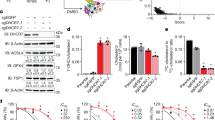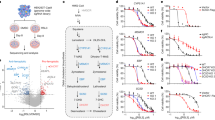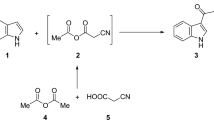Abstract
Plant sterols are found in fruits and vegetables. Their cholesterol-lowering effect is well documented. Our study aimed at comparing antiproliferative effects of 7β-hydroxysitosterol (7β-OHsito) versus 7β-hydroxycholesterol (7β-OHchol) on the human colon cancer cell line Caco-2. When cells were exposed for 32 h to 60 μM 7β-OHsito or to 30 μM 7β-OHchol, both compounds caused 50% growth inhibition. Cells treated with 7β-OHsito showed enhanced caspase-9 and -3 activities followed by DNA fragmentation. In contrast, 7β-OHchol did not activate caspase-3 and activation of caspase-9 and DNA fragmentation were delayed. The treatment of cells with the caspase inhibitor Z-VAD.fmk retarded the 7β-OHsito-induced apoptotic process but not that triggered by 7β-OHchol. Our data suggest that the two compounds in spite of their structural similarities target different cellular pathways, which lead to cell death.
Similar content being viewed by others
Log in or create a free account to read this content
Gain free access to this article, as well as selected content from this journal and more on nature.com
or
Abbreviations
- 7β-OHchol:
-
7β-hydroxycholesterol
- 7β-Ohsito:
-
7β-hydroxy sitosterol
- PI:
-
propidium iodide
- HMG-CoA reductase:
-
3-hydroxy-methylglutaryl coenzyme A reductase
- DMSO:
-
dimethyl sulfoxide
References
Tapiero H, Townsend DM and Tew KD (2003) Phytosterols in the prevention of human pathologies. Biomed. Pharmacother. 57: 321–325
Igel M, Giesa U, Lutjohann D and von Bergmann K (2003) Comparison of the intestinal uptake of cholesterol, plant sterols, and stanols in mice. J. Lipid Res. 44: 533–538
Christiansen LI, Lahteenmaki PL, Mannelin MR, Seppanen-Laakso TE, Hiltunen RV and Yliruusi JK (2001) Cholesterol-lowering effect of spreads enriched with microcrystalline plant sterols in hypercholesterolemic subjects. Eur. J. Nutr. 40: 66–73
Miettinen TA and Gylling H (2003) Non-nutritive bioactive constituents of plants: phytosterols. Int. J. Vitam. Nutr. Res. 73: 127–134
De Jong A, Plat J and Mensink RP (2003) Metabolic effects of plant sterols and stanols. J. Nutr. Biochem. 14: 362–369
Plat J, Kerckhoffs DA and Mensink RP (2000) Therapeutic potential of plant sterols and stanols. Curr. Opin. Lipidol. 11: 571–576
Clifton PM, Noakes M, Sullivan D, Erichsen N, Ross D, Annison G, Fassoulakis A, Cehun M and Nestel P (2004) Cholesterol-lowering effects of plant sterol esters differ in milk, yoghurt, bread and cereal. Eur. J. Clin. Nutr. 58: 503–509
Ostlund Jr RE, Racette SB and Stenson WF (2002) Effects of trace components of dietary fat on cholesterol metabolism: phytosterols, oxysterols, and squalene. Nutr. Rev. 60: 349–359
Plat J and Mnsink PP (2001) Effects of plant sterols and stanols on lipid metabolism and cardiovascular risk. Nutr. Metab. Cardiovasc. Dis. 11: 31–40
Kozlowska-Wojciechowska M, Jastrzebska M, Naruszewicz M and Foltynska A (2003) Impact of margarine enriched with plant sterols on blood lipids, platelet function, and fibrinogen level in young men. Metabolism 52: 1373–1378
Moghadasian MH (2000) Pharmacological properties of plant sterols in vivo and in vitro observations. Life Sci. 67: 605–615
Normen AL, Brants HA, Voorrips LE, Andersson HA, van den Brandt PA and Goldbohm RA (2001) Plant sterol intakes and colorectal cancer risk in the Netherlands Cohort Study on Diet and Cancer. Am. J. Clin. Nutr. 74: 141–148
Awad AB and Fink CS (2000) Phytosterols as anticancer dietary components: evidence and mechanism of action. J. Nutr. 130: 2127–2130
Fahy DM, O'Callaghan YC and O'Brien NM (2004) Phytosterols: lack of cytotoxicity but interference with beta-carotene uptake in Caco-2 cells in culture. Food Addit. Contam. 21: 42–51
Awad AB, Roy R and Fink CS (2003) Beta-sitosterol, a plant sterol, induces apoptosis and activates key caspases in MDA-MB-231 human breast cancer cells. Oncol. Rep. 10: 497–500
Awad AB, Downie AC and Fink CS (2000) Inhibition of growth and stimulation of apoptosis by beta-sitosterol treatment of MDA-MB-231 human breast cancer cells in culture. Int. J. Mol. Med. 5: 541–545
Awad AB, Fink CS, Williams H and Kim U (2001) In vitro and in vivo (SCID mice) effects of phytosterols on the growth and dissemination of human prostate cancer PC-3 cells. Eur. J. Cancer Prev. 10: 507–513
Awad AB, von Holtz RL, Cone JP, Fink CS and Chen YC (1998) Beta-sitosterol inhibits growth of HT-29 human colon cancer cells by activating the sphingomyelin cycle. Anticancer Res. 18: 471–473
Awad AB, Chen YC, Fink CS and Hennessey T (1996) Beta-sitosterol inhibits HT-29 human colon cancer cell growth and alters membrane lipids. Anticancer Res. 16: 2797–2804
Choi YH, Kong KR, Kim YA, Jung KO, Kil JH, Rhee SH and Park KY (2003) Induction of Bax and activation of caspases during beta-sitosterol-mediated apoptosis in human colon cancer cells. Int. J. Oncol. 23: 1657–1662
Daly GG, Finocchairo ET and Richardson T (1983) Characterization of some oxidation products of sitosterol. J. Agric. Food Chem. 31: 46–50
Lutjohann D (2004) Sterol autoxidation: from phytosterols to oxyphytosterols. Br. J. Nutr. 91: 3–4
Adcox C, Boyd L, Oehrl L, Allen J and Fenner G (2001) Comparative effects of phytosterol oxides and cholesterol oxides in cultured macrophage-derived cell lines. J. Agric. Food Chem. 49: 2090–2095
Maguire L, Konoplyannikov M, Ford A, Maguire AR and O'Brien NM (2003) Comparison of the cytotoxic effects of beta-sitosterol oxides and a cholesterol oxide, 7beta-hydroxycholesterol, in cultured mammalian cells. Br. J. Nutr. 90: 767–775
Witztum JL and Steinberg D (1991) Role of oxidized low density lipoprotein in atherogenesis. J. Clin. Invest. 88: 1785–1792
Biasi F, Leonarduzzi G, Vizio B, Zanetti D, Sevanian A, Sottero B, Verde V, Zingaro B, Chiarpotto E and Poli G (2004) Oxysterol mixtures prevent proapoptotic effects of 7-ketocholesterol in macrophages: implications for proatherogenic gene modulation. FASEB J. 18: 693–695
Lizard G, Monier S, Cordelet C, Gesquiere L, Deckert V, Gueldry S, Lagrost L and Gambert P (1999) Characterization and comparison of the mode of cell death, apoptosis versus necrosis, induced by 7beta-hydroxycholesterol and 7-ketocholesterol in the cells of the vascular wall. Arterioscler. Thromb. Vasc. Biol. 19: 1190–1200
Ji YH, Moog C, Schmitt G, Bischoff P and Luu B (1990) Monophosphoric acid diesters of 7 beta-hydroxycholesterol and of pyrimidine nucleosides as potential antitumor agents: synthesis and preliminary evaluation of antitumor activity. J. Med. Chem. 33: 2264–2270
Lim HK, Kang HK, Yoo ES, Kim BJ, Kim YW, Cho M, Lee JH, Lee YS, Chung MH and Hyun JW (2003) Oxysterols induce apoptosis and accumulation of cell cycle at G(2)/M phase in the human monocytic THP-1 cell line. Life Sci. 72: 1389–1399
Miguet-Alfonsi C, Prunet C, Monier S, Bessede G, Lemaire-Ewing S, Berthier A, Menetrier F, Neel D, Gambert P and Lizard G (2002) Analysis of oxidative processes and of myelin figures formation before and after the loss of mitochondrial transmembrane potential during 7beta-hydroxycholesterol and 7-ketocholesterol-induced apoptosis: comparison with various pro-apoptotic chemicals. Biochem. Pharmacol. 64: 527–541
Miguet C, Monier S, Bettaieb A, Athias A, Bessede G, Laubriet A, Lemaire S, Neel D, Gambert P and Lizard G (2001) Ceramide generation occurring during 7beta-hydroxycholesterol- and 7-ketocholesterol-induced apoptosis is caspase independent and is not required to trigger cell death. Cell Death Differ. 8: 83–99
Guardiola F, Codony R, Addis PB, Rafecas M and Boatella J (1996) Biological effects of oxysterols: current status. Food Chem. Toxicol. 34: 193–211
O'Callaghan YC, Woods JA and O'Brien NM (2002) Characteristics of 7 beta-hydroxycholesterol-induced cell death in a human monocytic blood cell line, U937, and a human hepatoma cell line, HepG2. Toxicol. In Vitro 16: 245–251
Schroepfer Jr GJ (2000) Oxysterols: modulators of cholesterol metabolism and other processes. Physiol. Rev. 80: 361–554
Theunissen JJ, Jackson RL, Kempen HJ and Demel RA (1986) Membrane properties of oxysterols. Interfacial orientation, influence on membrane permeability and redistribution between membranes. Biochim. Biophys. Acta 860: 66–74
Thompson EB and Ayala-Torres S (1999) Oxysterols and apoptosis: evidence for gene regulation outside the cholesterol pathway. Crit. Rev. Biochem. Mol. Biol. 34: 25–32
Olkkonen VM and Levine TP (2004) Oxysterol binding proteins: in more than one place at one time? Biochem. Cell Biol. 82: 87–98
Monier S, Samadi M, Prunet C, Denance M, Laubriet A, Athias A, Berthier A, Steinmetz E, Jurgens G, Negre-Salvayre A, Bessede G, Lemaire-Ewing S, Neel D, Gambert P and Lizard G (2003) Impairment of the cytotoxic and oxidative activities of 7 beta-hydroxycholesterol and 7-ketocholesterol by esterification with oleate. Biochem. Biophys. Res. Commun. 303: 814–824
Maier G, Bing G, Falken U, Wagner E and Unger C (1999) Antitumor activity and induction of apoptosis by water-soluble derivatives of 7beta-hydroxycholesterol in human colon carcinoma cell lines. Anticancer Res. 19: 4251–4256
Clifton P (2002) Plant sterol and stanols – comparison and contrasts. Sterols versus stanols in cholesterol-lowering: is there a difference? Atheroscler. Suppl. 3: 5–9
Skehan P, Storeng R, Scudiero D, Monks A, McMahon J, Vistica D, Warren JT, Bokesch H, Kenney S and Boyd MR (1990) New colorimetric cytotoxicity assay for anticancer-drug screening. J. Natl. Cancer Inst. 82: 1107–1112
Darzynkiewicz Z, Bruno S, Del Bino G, Gorczyca W, Hotz MA, Lassota P and Traganos F (1992) Features of apoptotic cells measured by flow cytometry. Cytometry 13: 795–808
Nicoletti I, Migliorati G, Pagliacci MC, Grignani F and Riccardi C (1991) A rapid and simple method for measuring thymocyte apoptosis by propidium iodide staining and flow cytometry. J. Immunol. Methods 139: 271–279
Gurtu V, Kain SR and Zhang G. (1997) Fluorometric and colorimetric detection of caspase activity associated with apoptosis. Anal. Biochem. 251: 98–102
Matassov D, Kagan T, Leblanc J, Sikorska M and Zakeri Z (2004) Measurement of apoptosis by DNA fragmentation. Methods Mol. Biol. 282: 1–18
Rabkin SW and Kong JY (2003) Lovastatin-induced cardiac toxicity involves both oncotic and apoptotic cell death with the apoptotic component blunted by both caspase-2 and caspase-3 inhibitors. Toxicol. Appl. Pharmacol. 193: 346–355
Cummings BS, Kinsey GR, Bolchoz LJ and Schnellmann RG (2004) Identification of caspase-independent apoptosis in epithelial and cancer cells. J. Pharmacol. Exp. Ther. 310: 126–134
Herr I and Debatin KM (2001) Cellular stress response and apoptosis in cancer therapy. Blood 98: 2603–2614
Hengartner MO (2000) The biochemistry of apoptosis. Nature 407: 770–776
Bauvy C, Gane P, Arico S, Codogno P and Ogier-Denis E (2001) Autophagy delays sulindac sulfide-induced apoptosis in the human intestinal colon cancer cell line HT-29. Exp. Cell Res. 268: 139–149
Bursch W, Ellinger A, Gerner C, Frohwein U and Schulte-Hermann R (2000) Programmed cell death (PCD). Apoptosis, autophagic PCD, or others? Ann. NY Acad. Sci. 926: 1–12
Kandutsch AA and Chen HW (1973) Inhibition of sterol synthesis in cultured mouse cells by 7alpha-hydroxycholesterol, 7beta-hydroxycholesterol, and 7-ketocholesterol. J. Biol. Chem. 248: 8408–8417
Luu B and Moog C (1991) Oxysterols: biological activities and physicochemical studies. Biochimie 73: 1317–1320
Peet DJ, Janowski BA and Mangelsdorf DJ (1998) The LXRs: a new class of oxysterol receptors. Curr. Opin. Genet. Dev. 8: 571–575
Taylor FR, Saucier SE, Shown EP, Parish EJ and Kandutsch AA (1984) Correlation between oxysterol binding to a cytosolic binding protein and potency in the repression of hydroxymethylglutaryl coenzyme A reductase. J. Biol. Chem. 259: 12382–12387
Adachi J, Fujita T, Kudo R, Asano M, Nurhantari Y and Ueno Y (2003) 7-hydroperoxycholesterol and oxysterols as indices of oxidative stress: chronic ethanol feeding and rat skeletal muscle. Leg. Med. (Tokyo) 1: 105–109
Ryan L, O'Callaghan YC and O'Brien NM (2004) Generation of an oxidative stress precedes caspase activation during 7beta-hydroxycholesterol-induced apoptosis in U937 cells. J. Biochem. Mol. Toxicol. 18: 50–59
Iimura O, Vrtovsnik F, Terzi F and Friedlander G (1997) HMG-CoA reductase inhibitors induce apoptosis in mouse proximal tubular cells in primary culture. Kidney Int. 52: 962–972
Rabkin SW and Kong JY (2003) Lovastatin-induced cardiac toxicity involves both oncotic and apoptotic cell death with the apoptotic component blunted by both caspase-2 and caspase-3 inhibitors. Toxicol. Appl. Pharmacol. 193: 346–355
Cregan SP, Dawson VL and Slack RS (2004) Role of AIF in caspase-dependent and caspase-independent cell death. Oncogene 23: 2785–2796
Tsujimoto Y (2003) Cell death regulation by the Bcl-2 protein family in the mitochondria. J. Cell. Physiol. 195: 158–167
Lockshin RA and Zakeri Z (2004) Caspase-independent cell death? Oncogene 23: 2766–2773
Berger A, Jones PJ and Abumweis SS (2004) Plant sterols: factors affecting their efficacy and safety as functional food ingredients. Lipids Health Dis. 3: 5–12
Kakis G and Kuksis A (1984) Effect of intravenous infusion of intralipid, cholesterol, and plant sterols on hepatic cholesterogenesis. Can. J. Biochem. Cell Biol. 62: 1–10
Li S, Pang J, Wilson W K and Schroepfer Jr GJ (1999) Sterol synthesis. Preparation and characterization of fluorinated and deuterated analogs of oxygenated derivatives of cholesterol. Chem. Phys. Lipids 99: 33–71
Schneider Y, Chabert P, Stutzmann J, Coelho D, Fougerousse A, Gosse F, Launay JF, Brouillard R and Raul F (2003) Resveratrol analog (Z)-3,5,4′-trimethoxystilbene is a potent anti-mitotic drug inhibiting tubulin polymerization. Int. J. Cancer 107: 189–196
Acknowledgements
We are grateful to Dr. Nikolaus Seiler for advice and critical reading of the manuscript. This work was supported by a grant from the Ministère de la Jeunesse, de l'Education Nationale et de la Recherche, France (RARE 015 No. 02 P 0641).
Author information
Authors and Affiliations
Corresponding author
Additional information
Edited by RA Knight
Rights and permissions
About this article
Cite this article
Roussi, S., Winter, A., Gosse, F. et al. Different apoptotic mechanisms are involved in the antiproliferative effects of 7β-hydroxysitosterol and 7β-hydroxycholesterol in human colon cancer cells. Cell Death Differ 12, 128–135 (2005). https://doi.org/10.1038/sj.cdd.4401530
Received:
Revised:
Published:
Issue date:
DOI: https://doi.org/10.1038/sj.cdd.4401530
Keywords
This article is cited by
-
Development and validation of a comprehensive two-dimensional gas chromatography–mass spectrometry method for the analysis of phytosterol oxidation products in human plasma
Analytical and Bioanalytical Chemistry (2012)
-
Ligands of the antiestrogen-binding site induce active cell death and autophagy in human breast cancer cells through the modulation of cholesterol metabolism
Cell Death & Differentiation (2009)
-
Mitochondrial perturbation, oxidative stress and lysosomal destabilization are involved in 7β-hydroxysitosterol and 7β-hydroxycholesterol triggered apoptosis in human colon cancer cells
Apoptosis (2007)



